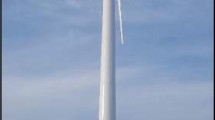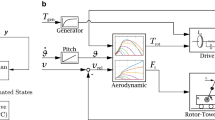Abstract
In this study, a peak shaving algorithm known as a control method to reduce peak mechanical loads in multi-megawatt wind turbines was designed and implemented to a medium capacity 100 kW wind turbine to solve overspeeding shutdown problem due to low moment of inertia of the rotor. The algorithm consists of a look-up table having an input of measured rotor speed and an output of blade pitch angle, and the output is added to the pitch command of the controller. The algorithm was firstly validated using a commercial aero-elastic simulation code, GH-Bladed, under low and high turbulence conditions. The simulation results clearly showed that the maximum rotor speed value causing an overspeed shutdown was reduced and that the mean power was slightly increased. In addition, the damage equivalent loads for the blade out-of-plane bending moment and tower fore-aft bending moment were reduced in the rated wind speed region. Field tests were also performed to confirm the validity of the simulation results. For the field test, the peak shaving algorithm was implemented to the original power control algorithm and it was uploaded to the programmable logic controller of the 100 kW wind turbine. It is concluded that applying the peak shaving method for multi-megawatt wind turbines to a medium capacity wind turbine with much lower rotor moment of inertia is effective in reducing overspeed shutdown problems and helps annual energy production as the result. In wind conditions where the average wind speed is 4.55% higher and the turbulence intensity is 11.81% higher, the maximum rotor speed and standard deviation causing an overspeed shutdown were reduced by − 2.06% and − 8.08%, respectively, with the proposed peak shaving algorithm. The results demonstrate convincingly that predicted improvement in simulation can be achieved in practice.



















Similar content being viewed by others
Abbreviations
- \( {\text{C}}_{\text{p}} \) :
-
Power coefficient
- \( {\text{C}}_{\text{t}} \) :
-
Thrust coefficient
- Ft :
-
Thrust force
- \( {\text{P}} \) :
-
Aerodynamic power
- Pelec :
-
Electrical power
- R:
-
Rotor radius
- \( {\text{T}}_{\text{g}}^{\text{rated}} \) :
-
Rated generator torque
- \( {\text{T}}_{\text{g}}^{c} \) :
-
Torque command
- u:
-
Signal of mode switch
- V:
-
Wind speed
- β:
-
Pitch angle
- β0 :
-
Fine pitch angle
- βc :
-
Pitch angle command
- βPS :
-
Pitch angle command for peak shaving
- ρ:
-
Air density
- λ:
-
Tip speed ratio
- Ωg :
-
Generator speed
- \( \varOmega_{\text{g}}^{\text{err}} \) :
-
Generator speed error
- \( \varOmega_{g}^{\text{rated}} \) :
-
Rated Generator speed
References
Kleperis, J., Fylenko, V. V., Vanags, M., Volkovs, A., Lesnicenoks, P., Grinberga, L., et al. (2016). Energy storage solutions for small and medium-sized self-sufficient alternative energy objects. Bulgarian Chemical Communications,48((E)), 290–296.
Bhandari, B., Poudel, S. R., Lee, K. T., & Ahn, S. H. (2014). Mathematical modeling of hybrid renewable energy system: A review on small hydro-solar-wind power generation. International Journal of Precision Engineering and Manufacturing-Green Technology,1(2), 157–173.
Hang, W. X., Tong, C. W., Hoe, W. K., Chin-Tsan, W., Huat, S. L., Chew, P. S., et al. (2018). Preliminary assessment of optimized accessorial roof shape for performance of wind turbine mounted on eco-roof system. International Journal of Precision Engineering and Manufacturing-Green Technology,5(3), 375–385.
Sung, C. M., & Han, M. C. (2016). Design and performance evaluation of hinge type pitch control system in small-size wind turbine. International Journal of Precision Engineering and Manufacturing-Green Technology,3(4), 335–341.
Engelen, T. G. (2006). Design model and load reduction assessment for multi-rotational mode individual pitch control. In European Wind Energy Conference. Athens, Greece.
Bossanyi, E. A. (2003). Individual blade pitch control for load reduction. Wind Energy: An International Journal for Progress and Applications in Wind Power Conversion Technology,6(2), 119–128.
Petrović, V., Jelavić, M., & Baotić, M. (2015). Advanced control algorithms for reduction of wind turbine structural loads. Renewable Energy,76, 418–431.
Kanev, S., & Van Engelen, T. G. (2009). Exploring the limits in individual pitch control. In Proceedings of European Wind Energy Conference (pp. 1–10).
Bossanyi, E., Wright, A., & Fleming, P. (2010). Further progress with field testing of individual pitch control. National Renewable Energy Lab (NREL), Golden
Bossanyi, E., Fleming, P., & Wright, A. (2013). Validation of individual pitch control by field tests on two-and three-bladed wind turbines. IEEE Transactions on Control Systems Technology,21(4), 1067–1078.
Kim, K., Paek, I., Kim, C., Kim, H., & Kim, H. (2016). Design of power and load reduction controller for a medium-capacity wind turbine. Journal of the Korean Solar Energy Society,36(6), 1–12.
Oh, Y., Kim, K., Kim, H., & Paek, I. (2015). Control algorithm of a floating wind turbine for reduction of tower loads and power fluctuation. International Journal of Precision Engineering and Manufacturing,16(9), 2041–2048.
Kim, C., Kim, K., & Paek, I. (2018). Design of tower damper gain scheduling algorithm for wind turbine tower load reduction. Journal Korean Solar Energy Society,38(2), 1–13.
Kim, C., Kim, K., Song, Y., & Paek, I. (2018). Tower load reduction control by pitch loop individual gain scheduling. Journal of Wind Energy,9(3), 25–32.
Nam, Y. S., & Im, C. H. (2012). Mitigation of Mechanical Loads of NREL 5 MW Wind Turbine Tower. Transactions of the Korean Society of Mechanical Engineers A,36(11), 1455–1462.
Savenije, F. J., & Peeringa, J. M. (2009). Aero-elastic simulation ofoffshore wind turbines in the frequency domain. Energy Research Center ofthe Netherlands. The Netherlands. Tech. Rep. Report, ECN-E-09-060.
Tong, W. (2010). Wind power generation and wind turbine design (pp. 240–244). USA: WIT press.
Peerigna, J., Brood, R., Ceyhan, O., Engels, W., & De Winkel, G. (2011). Upwind 20 MW wind turbine pre-design: Blade design and control. ECN, ECN-E-11-017, 1–53.
Ceyhan, O., & Grasso, F. (2014). Investigation of wind turbine rotor concepts for offshore wind farms. Journal of Physics: Conference Series,524(1), 1–10.
Corten, G. P., & Schaak, P. (2003). Heat and flux: Increase of wind farm production by reduction of the axial induction. In Proceedings of the European Wind Energy Conference.
Kim, H., Kim, K., & Paek, I. (2016). Power regulation of upstream wind turbines for power increase in a wind farm. International Journal of Precision Engineering and Manufacturing,17(5), 665–670.
Kim, H., Kim, K., Paek, I., Bottasso, C. L., & Campagnolo, F. (2016). A Study on the Active Induction Control of Upstream Wind Turbines for total power increases. In Journal of Physics: Conference Series, 753(3), 032014. (IOP Publishing)
Kim, H., Kim, K., & Paek, I. (2017). Model based open-loop wind farm control using active power for power increase and load reduction. Applied Sciences,7(10), 1–22.
Battisti, L., Benini, E., Brighenti, A., Dell’Anna, S., & Castelli, M. R. (2018). Small wind turbine effectiveness in the urban environment. Renewable Energy,129, 102–113.
Gao, R., & Gao, Z. (2016). Pitch control for wind turbine systems using optimization, estimation and compensation. Renewable Energy,91, 501–515.
Kim, K., Kim, H., Paek, I., Kim, H. G., & Son, J. (2019). Field validation of demanded power point tracking control algorithm for medium-capacity wind turbine. International Journal of Precision Engineering and Manufacturing-Green Technology, 1–7.
Kim, K., Kim, H., Kim, C., Paek, I., Bottasso, C. L., & Campagnolo, F. (2018). Design and validation of demanded power point tracking control algorithm of wind turbine. International Journal of Precision Engineering and Manufacturing-Green Technology,3(4), 335–341.
Kim, K., Kim, H., Song, Y., & Paek, I. (2019). Design and simulation of an LQR-PI control algorithm for medium wind turbine. Energies,12(12), 2248.
Hansen, M., Hansen, A., Larsen, T., Oye, S., Sorensen, P., & Fuglsang, P. (2005). Control design for a pitch-regulated, variable speed wind turbine. RISO-R-1500(EN). Roskilde: Riso National Laboratories.
Bossanyi, E. A. (2000). The design of closed loop controllers for wind turbines. Wind energy,3, 149–163.
Kim, J., Nam, Y., Park, J., & Moon, S. (2010). Control system design of a MW-class PMSG-type wind turbine. Journal of Wind Energy,1(1), 44–50.
Moon, J., Jang, J., Yoon, K., Joe, G., & Lee, K. (2011). Development of control system for 2 MW direct drive wind turbine. Journal of Wind Energy,2(1), 90–96.
Lim, C. (2017). Design and manufacture of small-scale wind turbine simulator to emulate torque response of MW wind turbine. International Journal of Precision Engineering and Manufacturing-Green Technology,4(4), 409–418.
Kim, K., Lim, C., Oh, Y. O., Kwon, I., Yoo, N., & Paek, I. (2014). Time-domain dynamic simulation of a wind turbine including yaw motion for power prediction. International Journal of Precision Engineering and Manufacturing,15(10), 2199–2203.
DNV GL-Energy. (2014). In Bladed Theory Manual: Version 4.6. Garrad Hassan & Partners Ltd.: Glasgow, UK.
Acknowledgements
This work was partly supported by the Korea Institute of Energy Technology Evaluation and Planning(KETEP) grant funded by the Korea government(MOTIE) (20153010024470, “Development of optimization engineering technology for small wind turbines” and 20184030201940, “Graduate track for core technologies of wind power system engineering”).
Author information
Authors and Affiliations
Corresponding author
Ethics declarations
Conflict of interest
On behalf of all authors, the corresponding author states that there is no conflict of interest.
Additional information
Publisher's Note
Springer Nature remains neutral with regard to jurisdictional claims in published maps and institutional affiliations.
Rights and permissions
About this article
Cite this article
Kim, K., Kim, HG. & Paek, I. Application and Validation of Peak Shaving to Improve Performance of a 100 kW Wind Turbine. Int. J. of Precis. Eng. and Manuf.-Green Tech. 7, 411–421 (2020). https://doi.org/10.1007/s40684-019-00168-4
Received:
Revised:
Accepted:
Published:
Issue Date:
DOI: https://doi.org/10.1007/s40684-019-00168-4




